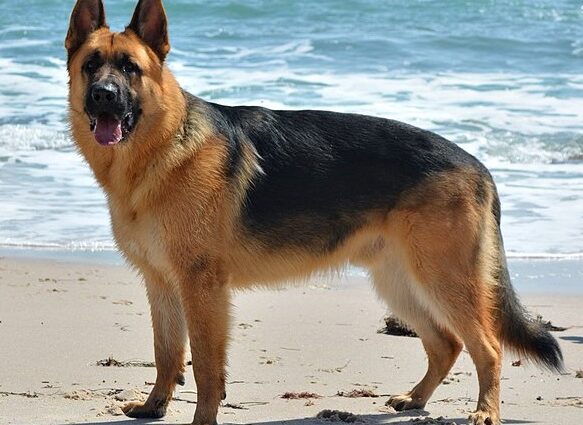Contents
German shepherd
Physical Characteristics
It is impossible not to recognize the German Shepherd at first glance with its powerful and muscular body of medium height, black muzzle, erect ears and bushy tail.
Poil : short and black, brown and fawn in color.
Size (height at the withers): 60-65 cm for males and 55-60 cm for females.
Weight : 30-40 kg for males and 22-32 kg for females.
Classification FCI : N°166.
Origins
The methodical breeding of the German Shepherd began in 1899 with the founding of the German Shepherd Dog Society (Association for German Shepherds), under the leadership of Max Emil Frédéric von Stephanitz, considered the “father” of the German Shepherd breed. The breed as we know it today is the result of crosses between different breeds of herding dogs found in the regions of Württemberg and Bavaria, in southern Germany. The objective displayed by the Company is to create a working dog capable of fulfilling the most demanding tasks. The first German shepherds arrived in France from 1910 and quickly carved out a solid reputation for themselves, which also stems from the fact that this dog, then called the Shepherd of Alsace, was considered a French breed stolen by Germany during the war of 1870.
Character and behavior
The German Shepherd is one of the most beloved breeds around the world due to its behavioral traits including high intelligence and learning ability, as well as unwavering courage and willpower. It is also a watchdog par excellence, endowed with a character that is at the same time authoritarian, faithful and protective. His cerebral faculties and his character make him one of the favorite dogs of the army and police forces. A guarantee of high quality.
Common pathologies and diseases of the German Shepherd
To see the abundant literature dealing with the diseases of the German Shepherd, one could believe this dog particularly weak and sensitive. In reality, this is simply because being the most popular dog, he is also the one that is the most studied. Here are some conditions to which it is particularly predisposed:
Degenerative myelopathy: it is a genetic disease causing progressive paralysis that begins in the animal’s hindquarters, before reaching the rest of its body. Without euthanasia, the dog most often dies of cardiac arrest because there is no curative treatment. A relatively inexpensive DNA test is available, however. A study by researchers at the University of Missouri showed that almost a third of the 7 German Shepherds tested carried the mutation responsible for the disease.
Anal fistulas: An immune system disorder quite common in German Shepherds leads to the formation of fistulas in the anal area. They are treated with anti-infective drugs, immunomodulatory therapy, or even surgery when previous treatments have failed.
Epilepsy: this inherited disorder of the nervous system is characterized by the recurrent occurrence of seizures.
Hémangiosarcome: the German Shepherd is considered to be the dog most predisposed to hemangiosarcoma, a very aggressive cancerous tumor that can develop in organs like the heart, liver, spleen, skin, bones, kidneys, etc. (1)
Ostéosarcome: this bone tumor causes deterioration of the general condition and lameness. It is detected with a biopsy coupled with histological analysis. Administration of anti-inflammatory drugs will provide relief to the affected animal, but amputation is necessary, sometimes combined with chemotherapy.
Living conditions and advice
The German Shepherd has a natural urge to learn and to serve. It is therefore necessary to make him do physical exercise on a daily basis and stimulate him by exercises or tasks to be completed. It is a dog of action which supports loneliness and passivity very badly. Due to their naturally domineering temperament, the German Shepherd requires strict training from an early age. His master must be firm and consistent on the rules to be imposed on the puppy. He is protective of the whole family, but can be jealous and does not always control his strength, so it is best to be vigilant about his relationship with young children.










